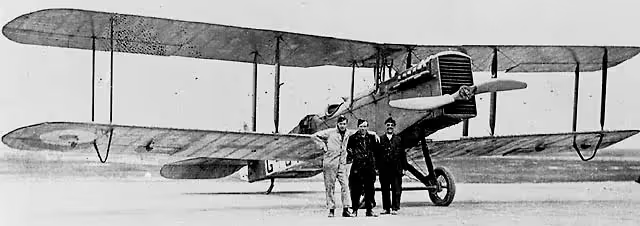Canadian Warplanes 2: de Havilland DH.4 and DH.9a
de Havilland DH.4 and DH.9a

(Library & Archives Canada Photo, MIKAN No. 3643537)
de Havilland DH.4, Reg. No. G-CYDM, Canadian Air Board, 4 Nov 1922.
de Havilland DH.4 (12) Reg. Nos. G-CYBO, G-CYBU- G-CYBW, G-CYCW, G-CYDB, G-CYDK, G-CYDL, G-CYDN, G-CYEC, G-CYEM.
The British DH.4 served as two-seat light day-bomber during the First World War. It was the first to have an effective defensive armament. It was powered by a number of different engines in its early years, including the 375 hp (280 kW) Rolls-Royce Eagle engine. It was armed with one 0.303 in (7.7 mm) Vickers machine gun for the pilot and one 0.303 in (7.7 mm) Lewis gun mounted on a Scarff ring for the observer. The DH.4 could carry a pair of 230 lb (100 kg) bombs or four 112 lb (51 kg) bombs. It was first flown in August 1916 and less than a year later, it entered operational service in France with No. 55 Squadron, RFC, on 6 March 1917.
Despite its success, numbers in service with the RFC actually started to decline from spring 1918, mainly due to a shortage of engines, and production switched to the DH.9. Unfortunately, the DH.9 proved to be inferior to the DH.4 in most respects.

(Library & Archives Canada Photo, MIKAN No. 3643564)
de Havilland DH.4, Reg. No. G-CYDM, Canadian Air Board, 1 Sep 1921.

(Library and Archives Canada Photo, MIKAN No. 3390141)
de Havilland DH.4, RAF, c1918.

(Library & Archives Canada Photo, MIKAN No. 3643560)
de Havilland DH.4, Reg. No. G-CYCW, Canadian Air Board, High River, Alberta, 29 May 1922.

(Library & Archives Canada Photo, MIKAN No. 3643529)
de Havilland DH.4, G-CYEC, High River, Alberta, 16 June 1923.

(Library & Archives Canada Photo, MIKAN No. 3643562)
Engine test stand at the Canadian Air Board station at High River, Alberta, 10 October 1921.

(Library & Archives Canada Photo, MIKAN No. 3643556)
de Havilland DH.4, G-CYEC, Canada Air Board, 27 May 1922.

(Library & Archives Canada Photo, MIKAN No. 3582839)
de Havilland DH.4, G-CYDL, Canada Air Board, engine overhaul, c1921.

(Library and Archives Canada Photo, MIKAN No. 3643548)
Wind-driven wireless generator on wing of DH.4 aircraft of the Canadian Air Board, High River, Alberta, 24 June 1922.

(Library & Archives Canada Photo, MIKAN No. 3643557)
de Havilland DH.4, G-CYEC, Canada Air Board, 27 May 1922.

(Library & Archives Canada Photo, MIKAN No. 3390123)
de Havilland DH.4 c1918, flown by Canadians in the RFC during the First World War.

(Library & Archives Canada Photo, MIKAN No. 3643563)
de Havilland DH.4, Reg. Nos. G-CYBU and G-CYDM of the Canadian Air Board, 1 Sep 1921.

(Library & Archives Canada Photo, MIKAN No. 3390131)
de Havilland DH.4, Reg. No. G-CYBO, Canadian Air Board, 1922.

(Library & Archives Canada Photo, MIKAN No. 3643547)
de Havilland DH.4, Reg. No. G-CYCW, Canadian Air Board, 28 June 1922.

(Library & Archives Canada Photo, MIKAN No. 3643547)
de Havilland DH.4, Reg. No. G-CYDB, Canadian Air Board, 28 June 1922.

(Library & Archives Canada Photo, MIKAN No. 3390133)
de Havilland DH.4, RCAG (Serial No. G-CYDN). 1924.

(Library & Archives Canada Photo, MIKAN No. 3388480)
DH.4, leaving Dawson, YT, July 1920. Although the pilot's cockpit is aft of the wings, the bulges on the wing leading edges which are part of the aileron control mechanisms were not used on the DH.9a. Alan Eyre.

(Library & Archives Canada Photo, MIKAN No. 3643557), (2)
Hucks Starter Vehicle, Canadian Air Board, 27 May 1922.

(Library & Archives Canada Photo, MIKAN No. 3643551)
Hucks Starter in use with DH. 4 aircraft of the Canadian Air Board, High River, Alberta, 17 June 1922.

(RCAF Photo)
de Havilland DH.9a in RCAF service, Camp Borden, Ontario.
The Airco DH.9A was a British single-engined light bomber designed and first used shortly before the end of the First World War. It was a development of the unsuccessful Airco DH.9 bomber, featuring a strengthened structure and, crucially, replacing the under-powered and unreliable inline 6-cylinder Siddeley Puma engine of the DH.9 with the American V-12 Liberty engine.
Colloquially known as the "Ninak" (from the phonetic alphabet treatment of designation "nine-A"), it served on in large numbers for the Royal Air Force following the end of the war, both at home and overseas, where it was used for colonial policing in the Middle East, finally being retired in 1931. Over 2,400 examples of an unlicensed version, the Polikarpov R-1, were built in the Soviet Union, the type serving as the standard Soviet light bomber and reconnaissance aircraft through the 1920s. (Wikipedia)
de Havilland DH.9a (12) Reg. Nos. G-CYAD, G-CYAJ, G-CYAK, G-CYAN, G-CYAO, G-CYAZ, G-CYBF, G-CYBI, G-CYBN, G-CYCG, G-CYDO, E991.

(Library & Archives Canada Photo, MIKAN No. 3390120)
de Havilland DH.9a, RAF, Hounslow, UK, 1919. These aircraft may have been part of No. 2 Squadron, Canadian Air Force (No. 123 Squadron (Canadian), RAF), which operated a communications flight from Hounslow.

(Library & Archives Canada Photo, MIKAN No. 3390121)
de Havilland DH.9a, RAF, Hounslow, UK, 1919. This aircraft may have been part of No. 2 Squadron, Canadian Air Force (No. 123 Squadron (Canadian), RAF), which operated a communications flight from Hounslow. The nose markings suggests 'C' Flight. Alan Eyre.

(Library & Archives Canada Photo, MIKAN No. 3390126)
de Havilland DH.9 Napier Lion, ca. 1918.

(Library & Archives Canada Photo, MIKAN No. 3523019)
de Havilland DH.9a, No. 2 Squadron (No. 123 Squadron (Canadian), RAF), Upper Heyford, Oxfordshire, England, 1919. No. 2 Squadron was formed as a day-bombing unit at Upper Heyford on 28 Nov 1918, flying the two-seat DH.9a on training until being disbanded at Shoreham-by-Sea, Sussex, on 5 Feb 1920.

(Library and Archives Canada Photo, MIKAN No. 3325144)
Captain C.M. McEwen in cockpit of de Havilland DH.9a, Reg. No. G-CYBU of the Canadian Air Board, 1921.

(Library and Archives Canada Photo, MIKAN No.3390139)
de Havilland DH.9a, Reg. No. G-CYBU of the Canadian Air Board, 1921.





